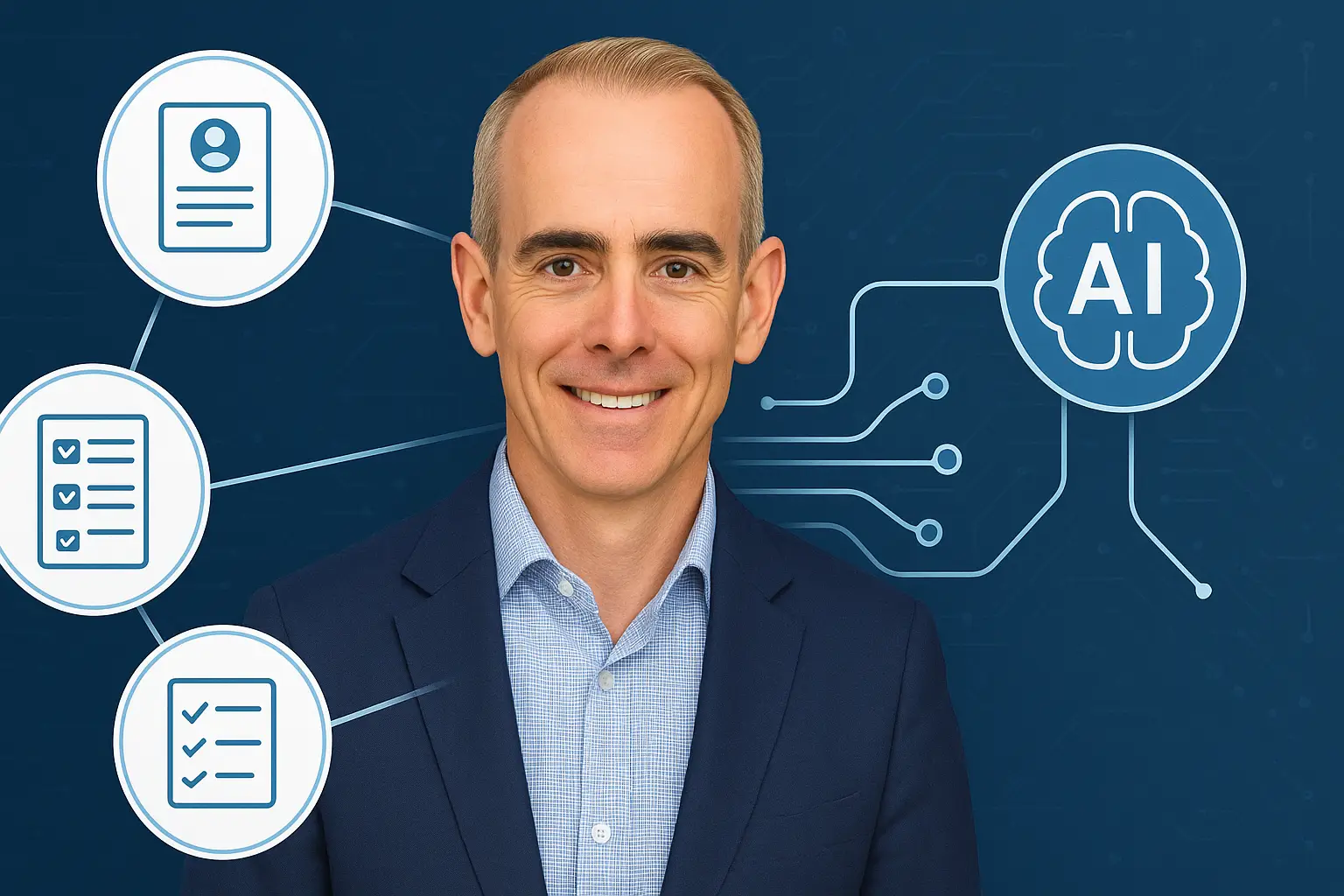What is RAG? What is a RAG Personal Knowledge Management System?
What if you could unlock the collective intelligence of your organization’s data in ways that transform decision-making, accelerate project delivery, and create competitive advantages? While everyone’s talking about AI transformation, I think the real opportunity lies in RAG (Retrieval-Augmented Generation) systems – AI that combines your specific documents and data with language models like ChatGPT, allowing you to get answers based on your own information rather than just general AI training.
The numbers tell an interesting story: RAG market projections show explosive growth from $300M in 2024 to $2.5B by 2030¹. Early adopters are already seeing 40-60% improvements in knowledge retrieval times and measurably better decision quality when teams can instantly access relevant historical data, project learnings, and expert insights.
In my conversations with leadership teams about AI implementation, the question isn’t whether to adopt these systems—it’s how quickly they can gain competitive advantage while others are still figuring out the basics. The organizations moving fastest are those treating RAG not as a tech experiment, but as a core business capability that amplifies human expertise across every function.
Setting up a RAG system can range from delightfully simple to hair-pullingly complex, all depending on your goals. Creating one for an individual is relatively straightforward—but for an organization, it’s a different beast entirely, thanks to the sheer volume of information involved.
In this article, I’ll guide you through building a personal professional development RAG system that can serve as your own AI-powered career coach, job search assistant, and workplace advisor. I’ll walk through the setup step by step, pulling from multiple data sources to create a well-rounded system.
With the system established, I’ll highlight some areas where you can put it to work including a deeper dive on a common use case – job seeking. While this article focuses on individual use, the core approach scales easily—from small teams to enterprise-level data ecosystems. And though I’ll only scratch the surface with a few specific scenarios, I hope to open up your mind to the many applications that a RAG knowledge management system can help with.
Data Privacy and Enterprise Considerations
Quick Privacy Setup: For Google NotebookLM users, which I will use in this example, disable “Gemini Apps Activity” in your Google account settings to prevent data from being used for model training. Other AI providers have varying default settings, so review privacy policies before uploading sensitive documents.
Enterprise Applications: While this demonstration uses consumer tools for proof of concept, enterprise RAG deployments require governance frameworks that address data sovereignty, access controls, audit capabilities, and integration with existing systems. Organizations typically start with individual implementations to build expertise before scaling enterprise-wide, treating RAG as a strategic capability rather than just a productivity tool.
The personal approach outlined here, provides hands-on experience with RAG’s analytical capabilities that often sparks ideas for enterprise-level applications and competitive advantages.
Building Your Personal RAG Knowledge Management System
For this exercise, I’ll use Google NotebookLM, though you can apply these principles to other platforms with project capabilities like ChatGPT or Claude. I currently prefer Google Notebooks because it allows up to 50 sources—far more than many alternatives.
Step 1: Access Google Notebooks and Create Your Foundation
First, ensure you have access to Google NotebookLM. If you have a Gmail account, you can quickly access it at https://notebooklm.google. Sign in with your Google account, and you should see the main interface. You should see something like this:

Create a new notebook by clicking ‘Create’.
Step 2: Document Preparation and Upload
The foundation of your personal RAG knowledge management system lies in the quality and breadth of documents you upload. For the purposes of this RAG, a professional development and career coach, I’m going to upload information relevant to that purpose. The types of documents I will add include:
Professional Documents: Covering performance history, work style, and results delivery methods and may include:
- Resumes and CVs from different career stages
- Performance reviews and feedback forms
- 360-degree feedback reports
- Professional development plans
Personal Assessment Results: Over the years, I’ve accumulated numerous assessments that provide valuable insights. Your list of assessments may vary but for this example, I’ll be adding:
- Myers-Briggs Type Indicator (MBTI) results
- StrengthsFinder Assessment
- Kolbe A Index Assessment
- Standout Assessment
- DISC personality profiles
- Sparketype Assessment
- Emotional intelligence evaluations
- Leadership style assessments
Before adding these documents, I have to address one of the biggest issues with RAG’s – getting the data into a format that it understands. For this example, this means converting anything that has a proprietary format, like a Microsoft Word document, into something that Google NotebookLM can read. This is straightforward – I just need to convert everything to either a text file or a pdf.
Once the documents are ready to upload, click on the “+Add” button:

A separate dialog box appears and I’ll select the type of source corresponding to the nature of the document I’m uploading. Note also that one can provide website links to sources. For this RAG, I’ll provide my LinkedIn profile URL as a website source also. My resultant Sources section now looks like this:

As you upload each document, Google provides an automatic summary. Simply click on any source to see how the system interprets that document. For example, my Marketing DNA document assessment generates a summary of my communication style as outlined in the document thus:
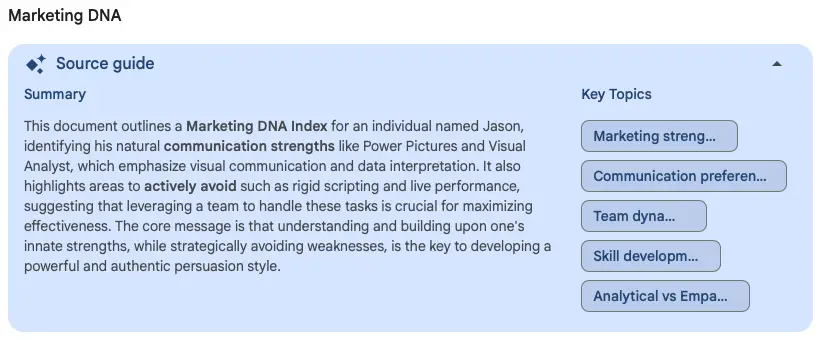
Once complete, Google generates a high-level summary for all uploaded documents in the center of the Chat pane:
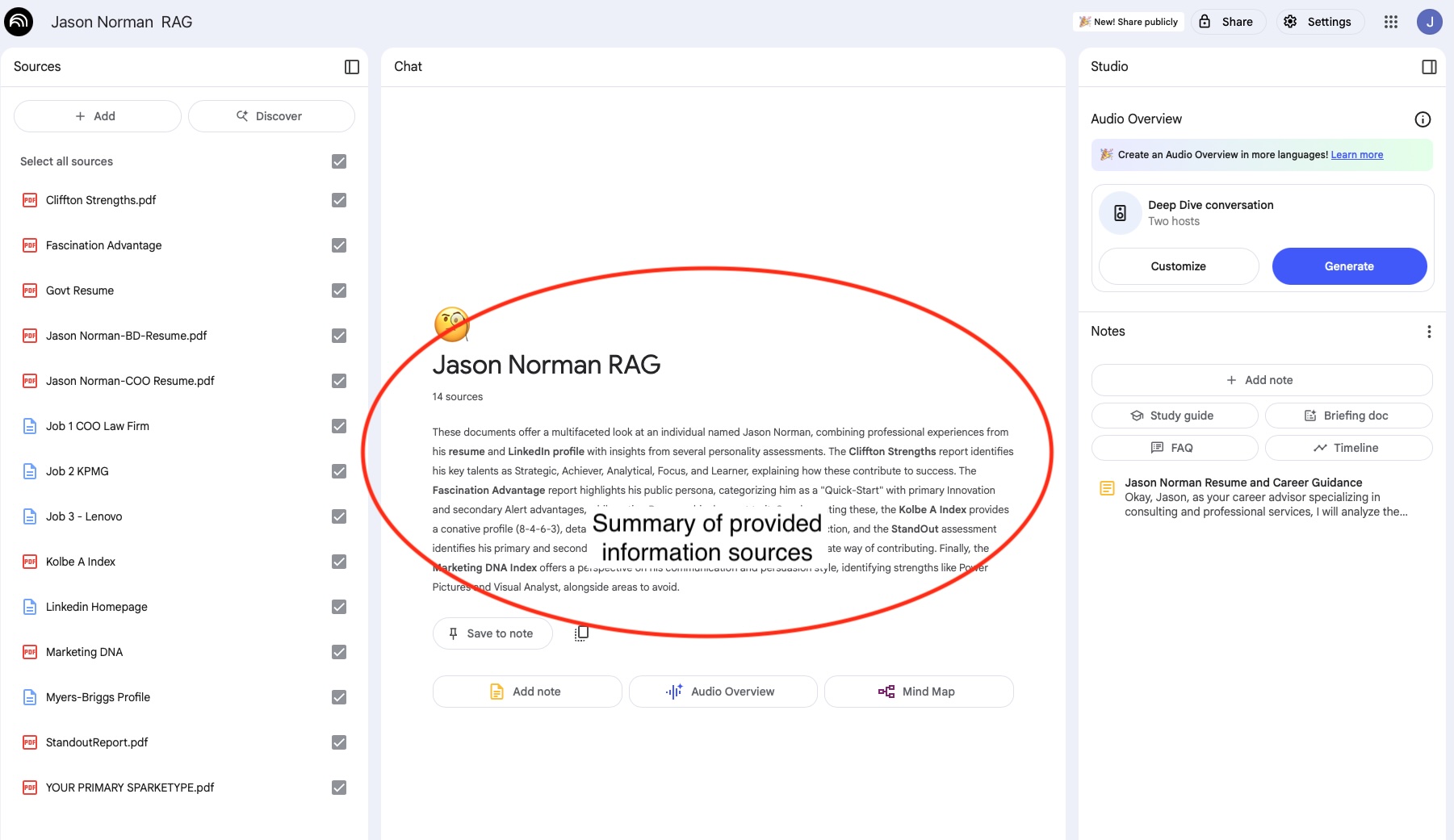
This self-generated overview helps verify that the system is processing your information correctly. You can also provide some queries at the bottom of the chat and test whether the RAG system is working. Google provides some starter suggestions that can be fun to explore.
Putting Your RAG to Work
With the RAG system in place, I can start putting it to work. Following are some ideas where it can provide insights to various problems:
Professional Development & Strategy
- Skills Gap Analyzer: Compare your current capabilities against industry trends or specific role requirements to identify upskilling opportunities
- Personal Brand Consultant: Generate consistent messaging for LinkedIn profiles, speaking bios, and networking pitches based on your achievements and personality
- Interview Preparation Coach: Create tailored responses to common interview questions using your actual experiences and communication style
Communication & Relationships
- Meeting Preparation Assistant: Brief you on attendees’ working styles and suggest optimal communication approaches based on your personality profile
- Conflict Resolution Advisor: Provide personalized strategies for workplace disagreements based on your conflict resolution tendencies and past feedback
- Networking Strategy Guide: Suggest conversation starters and relationship-building approaches aligned with your personality and professional background
Leadership & Management
- Team Composition Optimizer: Recommend team structures and role assignments that complement your leadership style and past successful collaborations
- Delegation Assistant: Suggest which tasks to delegate and to whom, based on your strengths, weaknesses, and management feedback history
- Performance Review Preparation: Generate self-assessment content and goal-setting frameworks using your career trajectory and feedback patterns
Strategic Planning
- Career Pivot Analyzer: Evaluate potential career transitions by mapping your transferable skills, personality fit, and past adaptability indicators against new industries or roles
As you start to explore, you’ll note that the system, like many things, is only as good as the data that you provide – the source documents in this case. The more relevant information you add, the better the RAG system becomes at answering questions specific to that information.
With that all said, let’s explore how one might use a personal RAG system…
A Working Example: Job Seeking
Given recent industry restructuring and the evolving talent landscape, many professionals are reassessing their career positioning and exploring new opportunities. Whether supporting colleagues through transitions or conducting strategic career planning, a RAG system provides unprecedented analytical depth for matching skills, experience, and working styles to optimal opportunities.
This example demonstrates how to leverage RAG for sophisticated career analysis—the same analytical rigor that drives successful business strategy, applied to individual career positioning. The methodology works equally well for internal mobility assessments, succession planning, or exploring external market opportunities. In this example, I’ll cover the last of these, and which I’ll break into three main activities:
- Analyzing multiple job postings to determine the best fit for skills, experience, and working style
- Tailoring resumes to maximize interview chances
- Saving outputs for future reference and RAG system enhancement
Step 1: Prioritizing the perfect job opportunity
Let’s say someone is exploring senior leadership positions and wants to make data-driven decisions about the best strategic fit. Like any good business analysis, this requires evaluating multiple options against clear criteria to optimize outcomes.
For this example, I’ll analyze three leadership opportunities that represent different strategic directions: a COO role at a law firm emphasizing operational excellence, a KPMG coaching director position focused on talent development, and a transformation director role at Lenovo requiring change management expertise.
To do this, I copy and paste each job description, save it as a text source within the RAG system, and give it a memorable, relevant name. Here, I’ve added three job descriptions, Job 1: COO at a Law Firm, Job 2: KPMG Coaching Director, and Job 3: A Transformation Director at Lenovo.
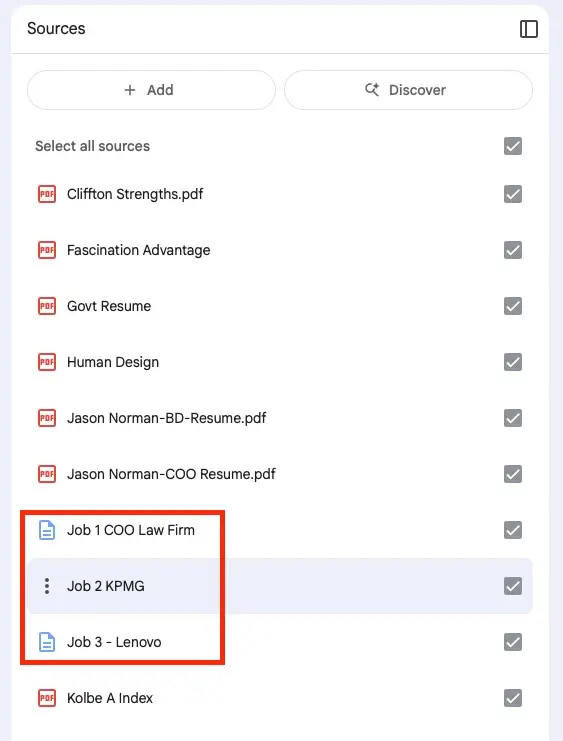
Next, I’ll create a prompt to do a deep-dive on each opportunity and determine which is the best fit, based on my RAG system data. You’ll note that this is a detailed prompt where I’m asking the RAG to evaluate each job against common criteria and then provide me a ranking. I’ll insert the below prompt at the bottom of the Chat section:
You are a professional career advisor. Analyze three job descriptions against Jason's profile using his uploaded documents. **TASK:** Evaluate how well each job aligns with Jason's background, skills, personality, and career goals from his source documents. **METHOD:** 1. Create 10 evaluation criteria from the job requirements 2. Score each job 1-10 on each criterion (1=poor fit, 10=excellent fit) 3. Provide total scores and recommendation **OUTPUT FORMAT:** Create a table summarizing high-level information **EVALUATION CRITERIA:** [List 10 criteria] **SCORING:** **Job 1:** [Title] - [Score 1]/10, [Score 2]/10... **Total: X/100** **Job 2:** [Title] - [Score 1]/10, [Score 2]/10... **Total: X/100** **Job 3:** [Title] - [Score 1]/10, [Score 2]/10... **Total: X/100** **RECOMMENDATION:** Top choice: [Job Title] (X/100) - [2-3 sentences why this is best for Jason based on his documents]The RAG responds with a comprehensive analysis, evaluating each position against criteria including strategic leadership, innovation focus, team development, analytical decision-making, communication skills, adaptability, commercial acumen, technical expertise, operational management, and external engagement. It’s a lot of information, too much to post here, but below is the summary table generated:
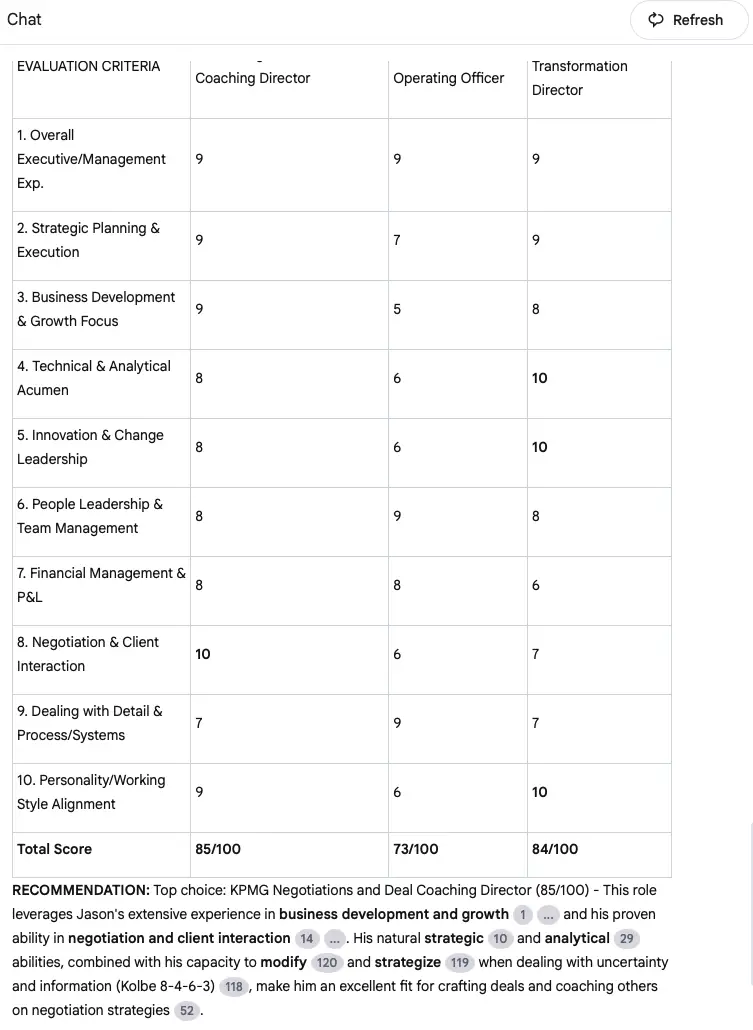
You’ll note that the recommendation is drawing both my experience, highlighting specific skillsets as well as drawing upon some of my personality assessment information. When the RAG system references source information, it provides a link back to the specific source – this can be handy for double-checking or exploring a recommendation in more detail. In this example, I might be curious in understanding why my working style and personality are low for the COO role but not the others. This analysis helps you understand not just the high scores but also the potential challenges. Even if a role scores well overall, low scores in specific areas might be deal-breakers depending on your personal fulfillment criteria. Importantly, this step can help you critique; ‘Is this job a real fit for me, or am I just enamored by the title / salary?’.
This analytical approach—systematic evaluation against multiple criteria with data-driven scoring—mirrors the strategic frameworks used in business decision-making. Whether evaluating market opportunities, potential partnerships, or investment options, the same rigorous methodology applies. In an era where career decisions increasingly require the same strategic thinking as business decisions, having tools that provide this level of analytical depth becomes a significant competitive advantage.
The ability to rapidly analyze complex opportunities, identify optimal strategic positioning, and make data-informed decisions represents exactly the kind of analytical capability that drives successful outcomes in both career navigation and business strategy.
Step 2: Creating a Killer Resume
Once optimal opportunities are identified through systematic analysis, the next step involves strategic positioning—clearly articulating relevant capabilities and experience in ways that demonstrate strong strategic fit. This mirrors how successful businesses position their offerings: understanding the market need, identifying competitive advantages, and communicating value propositions that resonate with decision-makers.
The same RAG system can analyze opportunity requirements and help craft positioning materials that maximize competitive advantage. Whether for internal mobility discussions, external opportunities, or business development initiatives, the approach remains fundamentally similar: strategic analysis followed by targeted communication.
Picking up from where I left off, I’ll use the RAG system to analyze job requirements and create a resume accordingly. First, deselect irrelevant job sources (Jobs 1 and 3) to focus the analysis on Job 2. Then use a detailed prompt like:
You are a professional resume writer specializing in consulting and professional services roles. Analyze the KPMG job description and help Jason create an optimized resume. **TASK:** 1. Extract key requirements, skills, and keywords from the KPMG job description 2. Review Jason's previous resumes and career documents in the source library 3. Create a tailored 2-page resume that maximizes his interview chances **ANALYSIS STEPS:** - Identify 15-20 critical keywords and requirements from the KPMG role - Compare these against Jason's documented experience, skills, and achievements - Note alignment strengths and any gaps to address through positioning **RESUME REQUIREMENTS:** - Professional format suitable for KPMG's corporate environment - Lead with Jason's most relevant experience and quantified achievements - Incorporate KPMG-specific keywords naturally throughout - Highlight transferable skills that match their requirements - Address any experience gaps through strategic positioning of related work - Include metrics and results wherever possible from his documented history **OUTPUT:** Complete 2-page resume formatted for easy reading, optimized for ATS systems, and tailored specifically to increase Jason's chances with this KPMG opportunity.
The RAG system conducts detailed analysis, drawing upon specific sources within my data to provide evidence of relevant skills and experience. It restructures my source resumes to emphasize the most pertinent qualifications while maintaining authenticity to my actual background. My resume is rewritten and optimized for ATS (Applicant Tracking System) while also being formatted to best match the preferred style of a KPMG recruiter. If this job is a good fit, then my RAG system has greatly helped me present myself as best as possible. Obviously, you can use the same approach to provide a cover letter that further supports candidacy.
Step 3: Save and Build
One of Google NotebookLM’s most valuable features is the ability to save results for future reference. You can even add saved conversation results as sources that further build upon your RAG system, creating a continuously evolving knowledge base:
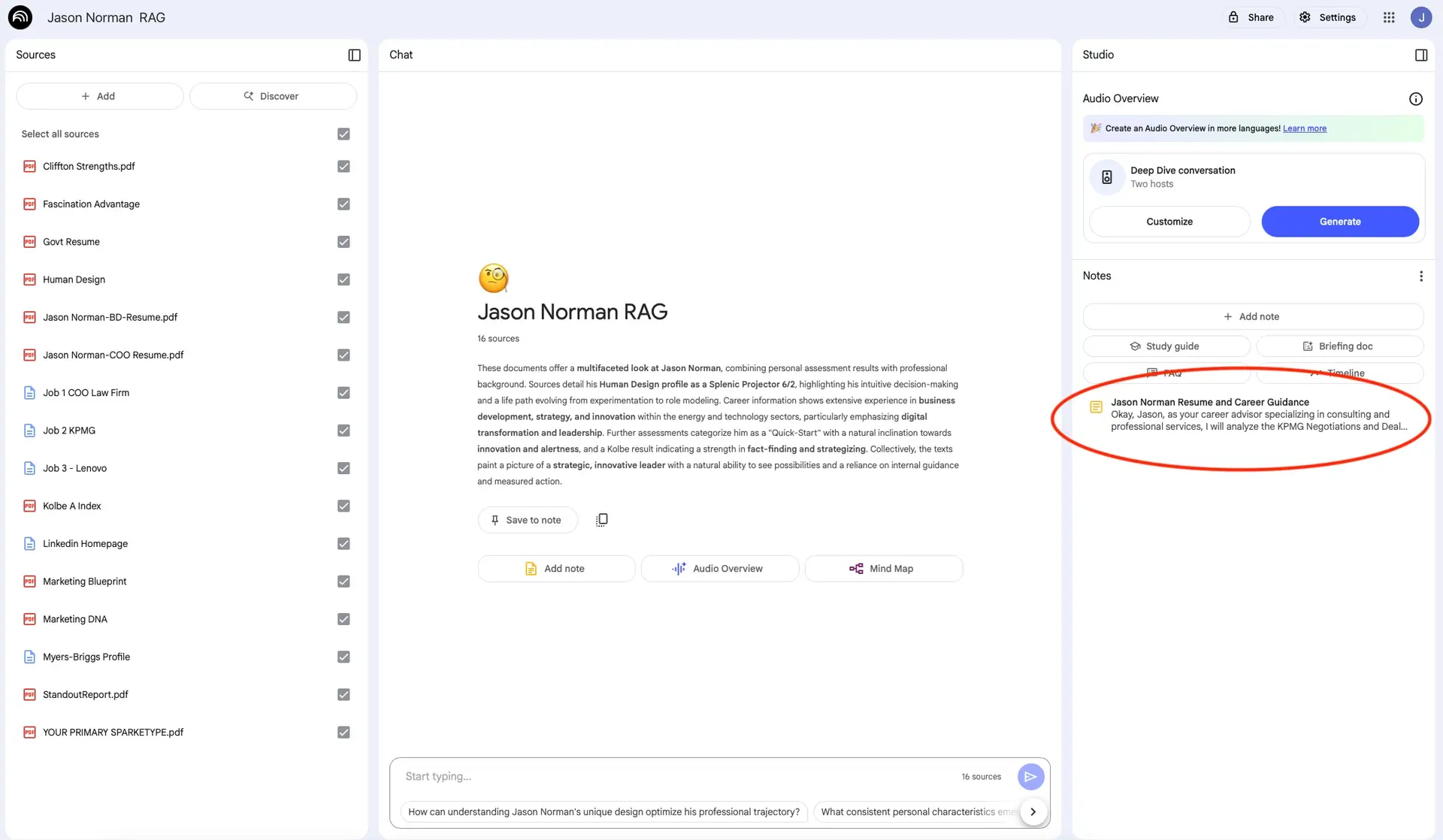
Click ‘Save to Note’ at the bottom of the output, and the entire conversation appears in the right section, creating a permanent record of your analysis and outputs. This allows you to reference previous work when writing cover letters or preparing for interviews.
Pro tip: As your RAG system grows, you may hit Google’s 50-document source limit. Not a problem – simply combine multiple sources into a single file and upload that (now larger) file in place of those that it replaces.
There you have it – job done – aside from the interview that is…
Expanding Your RAG System
Before exploring additional applications, it’s worth noting that the analytical rigor demonstrated in the career example applies broadly to strategic decision-making. Organizations and individuals who systematically analyze opportunities, understand competitive positioning, and make data-informed decisions consistently outperform those relying on intuition alone. The RAG approach provides a framework for bringing this analytical discipline to any domain where better decisions create competitive advantage.
A personal RAG can serve many purposes beyond career development and strategic analysis. The same systematic approach to data organization and insight generation can transform decision-making across multiple life domains:
- Financial RAG: Manage your finances with ease by integrating bank statements, investment reports, tax returns, and insurance policies. Create personalized strategies for budgeting, investment planning, and tax optimization.
- Health and Wellness RAG: Store medical records, fitness data, nutrition logs, and family health history. Receive tailored wellness recommendations that are unique to your health goals and history.
- Educational RAG (for Parents): Organize school reports, teacher feedback, extracurricular activities, and learning assessments. Use the system to develop personalized educational strategies that align with your child’s learning journey.
- Creative Development RAG: If you’re in a creative field, compile portfolio pieces, client feedback, creative briefs, and inspiration collections to track progress and generate new project ideas aligned with your evolving style.
The Enterprise Multiplier Effect
Individual RAG systems are just the beginning and the above examples provide a taste as to how they can add value and some of the steps needed to make that a reality. However, the real transformation happens when organizations deploy RAG capabilities across teams, departments, and entire business units. Consider these enterprise applications already showing measurable ROI:
Client Engagement RAG: Law firms using client history, case precedents, and team expertise data to craft winning proposals 60% faster while improving win rates by 25%.
Project Intelligence RAG: Consulting teams accessing lessons learned, methodology libraries, and expert knowledge to reduce project risk and accelerate delivery timelines.
Institutional Knowledge RAG: Companies capturing departing employees’ expertise, tribal knowledge, and decision-making frameworks to prevent knowledge loss and accelerate new hire productivity.
Organizations that systematize their knowledge assets gain sustainable competitive advantages while reducing operational friction and decision-making delays.
From Analysis to Strategic Advantage
The RAG system demonstrated here represents more than a productivity tool—it’s a framework for systematic analysis and strategic thinking that applies across personal and professional domains. Whether supporting colleagues through career transitions, exploring strategic opportunities, or driving business decisions, the underlying approach remains consistent: organize relevant data, ask strategic questions, and generate insights that inform better decisions.
In an environment where change is constant and opportunities emerge rapidly, having analytical frameworks that can quickly assess complex situations becomes increasingly valuable. The professionals and organizations that thrive are those who can systematically evaluate options, understand competitive positioning, and act decisively based on data-driven insights.
For those interested in exploring how these analytical approaches can drive better outcomes—whether for personal strategic planning or organizational decision-making—I’m always keen to discuss practical applications and share insights from implementation experience. The intersection of systematic analysis and strategic thinking creates opportunities in ways that purely intuitive approaches simply cannot match.
Good luck with your RAG!

